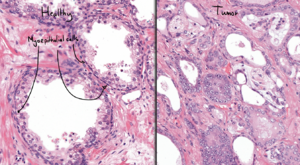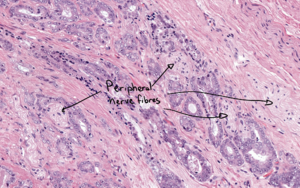33. Prostatic adenocarcinoma: Difference between revisions
(Created page with "'''Staining''': HE '''Organ''': Prostate '''Description''': The glands of the healthy, central zone are dilated and normal. The glands of the tumor are smaller, show atypia with very prominent nucleoli and they are not surrounded by basal (myoepithelial-like) cells. Perineural infiltration, the infiltration of the tumor around peripheral nerve fibres, is present. The nerve fibres are present just beneath and inside the capsule. Signs of benign prostate hyperplasia a...") |
(No difference)
|
Revision as of 19:09, 15 November 2022
Staining: HE
Organ: Prostate
Description:
The glands of the healthy, central zone are dilated and normal. The glands of the tumor are smaller, show atypia with very prominent nucleoli and they are not surrounded by basal (myoepithelial-like) cells.
Perineural infiltration, the infiltration of the tumor around peripheral nerve fibres, is present. The nerve fibres are present just beneath and inside the capsule.
Signs of benign prostate hyperplasia are seen in the areas of the slide not affected by the tumor.
Diagnosis: Prostatic adenocarcinoma
Risk factors:
- Old age
- Positive family history
- BRCA mutation
- HPC-1 mutation
Theory:
Benign prostatic hyperplasia mostly affects the transitional zone while cancer mostly affects the peripheral zone.



